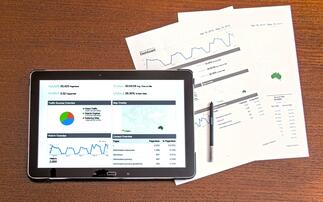Key points
- The prototype of the pensions dashboard was launched in April
- Challenges around data quality and standards need resolving
- Some element of compulsion may be needed to solve issues
The prototype of the pensions dashboard was unveiled in April. Charlotte Moore looks at the project to create dashboards and assesses some of the challenges yet to come
The creation of a 'pensions dashboard' sounds like a worthy IT project rather than an innovative tool that could revolutionise consumer behaviour. But ensuring employees can check the value of all their pension pots in one place has the potential to overcome the issues that undermine the success of auto-enrolment.
Providing pensions through an employer is efficient because it makes access to retirement products much cheaper as they do not have be sold individually. It can, however, result in scheme members amassing a large number of pension pots as employees no longer spend decades at the same company.
Geraldine Brassett, chair of the Pensions Administration Standards Association's (PASA) dashboard working group, explains: "The average number of jobs in a working life is now 11." This, in combination with a high volume of corporate activity, can make it very difficult for employees to keep track of all of their pension pots, she adds.
Keeping track of an employee's retirement assets is not the only issue - it's also much less efficient to have a large number of smaller value pots. Administrative charges tend to be higher and erode the overall value of the assets.
Sir Steve Webb, former pensions minister and director of policy at Royal London, says: "The last government wanted to tackle this issue by allowing the pension pot to follow the member." In other words, when an employee changed job, they could take their pension pot with them.
But the pensions industry disliked this policy intensely. Webb says: "Pension providers did not want the administrative headache this would create nor did they want to lose assets."
Dashboard development
The pensions dashboard was proposed as an alternative, as it would allow members to keep track of the value of their assets no matter how many times they changed jobs.
At first glance, production of a pensions dashboard should be possible: Australia, the Netherlands and various Nordic countries already have similar systems. But it's dangerous to extrapolate too far from other countries, cautions Yvonne Braun, director of long-term savings and protection for the ABI.
"Most of these countries have much smaller populations than the UK and a much less fragmented market - we have 46,000 schemes," says Braun. That makes it much harder to get this kind of project off the ground, she adds.
The government wants a working dashboard to be launched by 2019. The Association of British Insurers is overseeing the project on behalf of the HM Treasury and working in collaboration with insurance companies, third-party administrators, major master trusts and employee benefit consultancies.
Phase one has been completed - last month the prototype was launched. Braun says: "The prototype showed that, from a technological point of view, this is a viable project."
The scale of that achievement should not be understated. Daniel Hockley, group director at ITM, says: "The ABI managed to cajole people into developing a simple, starting solution."
Challenges
While the prototype is nowhere as near as complex as the final version of the dashboard, it has raised many of the potential issues. These issues will be much easier to address because the various industry players are now talking the same language as the technology providers, he adds.
However, there are still significant challenges. There is a lack of technological consistency. Hockley says: "There are a huge number of varied systems with a vast number of different data standards."
This should be addressed in the next phase of the project. Braun says: "We now need to ensure most of the industry can get their data up to a common standard so it can be easily uploaded."
The dashboard will only be a success if it has sufficient coverage. Brassett says: "Consumers will want to see all their pensions." While it might be impossible to ensure total coverage, the dashboard should aim to provide 90% of the population with 90% of the pensions, adds Braun
To ensure a high level of coverage, it either has to be very easy for pension providers to supply their data voluntarily or there has to be some element of compulsion, says Brassett.
Webb agrees: "The government will have to legislate to ensure every pension scheme and provider supplies data." If this is not done, the project will be undermined because it will be like a jigsaw with missing pieces, he adds.
"There is no incentive for pension schemes to voluntarily submit this data - this is just an additional cost," adds Webb.
That legislation would be necessary because getting the data into good shape will require considerable work for some pension schemes. Webb says: "There are plenty of schemes that still have their data in filing cabinets rather than in a digital form."
Third-party administrators could help to solve this data collection conundrum, as these organisations look after many thousands of schemes. Braun says: "Rather than having to approach thousands of schemes, a pension finder service will only have to connect to a couple of hundred organisations."
Engaging users
Another challenge is presentation. Hockley says: "One of the trickiest decisions is how to present this data to the user." The dashboard must appeal to people aged between 20 and 65.
Some people will want to access this data over their phones while others will prefer to look at it on their computer at work. Hockley says: "Designing a system that will work on different platforms and appeal to all age groups will be a significant challenge."
It's important to get the basics right: such as making sure it's easy to log on and easy to find the information the employee requires.
Careful thought has been given as to how to present this data to make it is meaningful to the user. Hockley says: "It's vital that the dashboard helps people to be more engaged with pensions."
The introduction of auto-enrolment has forced the pensions industry to think more carefully about how to communicate effectively with the end consumer. Pension providers increasingly realise they need to use language and concepts that scheme members understand.
For example, while it is interesting to know the current value of all the different pension pots, it's much more useful to know what level of retirement income this could provide.
Braun says: "In response to consumer research, the prototype has been designed to show scheme members their expected retirement income."
To make the dashboard truly effective, it needs to encourage members to make the right decisions to have a better retirement. That requires more than just data.
Matthew Burrell, senior DC policy adviser at PLSA, says: "There is very little point in providing the blank data without also providing retirement planning tools."
The combination of well-presented data and using the insights provided by behavioural finance can encourage members to tackle important issues. Brassett says: "These tools could get people to think about how much they need at retirement and how much they want."
Once a realistic income target has been set, they could then start to think about how much they need to contribute to achieve that goal, says Brassett.
Braun agrees: "The dashboard should be helping members to map out a retirement path, showing them not only what they have to do to achieve that goal but also encouraging them to take those steps early in their career."
Burrell agrees: "We should use all of the expertise in the financial services sector to improve member engagement in the UK."
As well as encouraging members to increase contributions, the dashboard could also help members to manager their pension pots more efficiently. Braun says: "We can build tools to show members the benefits of consolidating their pension pots."
But Burrell is concerned that such tools should be impartial. "We think there is a role for the FCA to ensure these tools present information in a fair and reasonable manner," he says. The tools should not be designed to help a company to sell financial products but to ensure members use their pots more effectively, he adds.
Keeping it simple
It's important, however, not to be carried away by the endless possibilities of the pensions dashboard. Brassett says: "To have any chance of achieving those goals, we need to focus on keeping it simple at first and adding the rest incrementally."
Braun agrees: "We should focus on future proofing the current model and focus on building the basics at the beginning." Just showing people how much likely income all their pension pots could provide will be considerable improvement on the current circumstances, she adds.
But achieving the full potential of dashboard will require more than the industry working well together - it will need encouragement from the government and regulatory oversight. Webb says: "The government is being too 'hands off' at the moment - it should be providing more impetus to this project."







